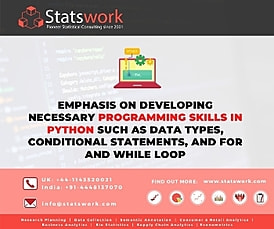Brief :
- Python is the most popular languages for its diverse set of applications; it has application in web development, machine learning, data analysis, and so on.
- It is an interpreted, interactive, object-oriented programming language. Statistics coursework homework help you in executing external command through Python.
- Some researchers feel it challenging to work with expectation. If an error occurred on a line execution of codes stops. Experts from Multiple regression analysis services know to handle expectations in Python using try-expect block.
Python is used to write simple programs but also possesses the full power required to create complex large enterprise solutions
- Datatypes and variables
When first starting with Python, you’ll need a firm grasp on the different types of data available to you and how to assign variables, which allow you to store data that can then be used later on throughout your coding. Like many other languages, Python does not place a strong emphasis on defining the data type of an object Factor Analysis as a Statistical Method helps to make coding much more straightforward.
Python provides three different data types :
- Numbers
- Strings
- Booleans
Numbers
- There are three main types of numbers available
- Integers, Floating point numbers, Complex numbers.
Integers:
- Integers comprise of whole numbers.
- Each integer has a memory associated with it, for example, 0 will take 24 bytes, and 1 will take 28 bytes.
Floating-point numbers:
- It refers to positive and negative decimal numbers such as 3.1, 5.0, -3.24543.
Complex numbers:
- Complex numbers require two different values, the first part is a real of the complex number, and the second value will be imaginary and represented with a ‘j’.
String:
It is a data type used in a programming language, which used to represent text rather than numbers. A string is the collection of character within single or double quotation mark. For example ‘Hello World’ well that’s a string. See how that uses a single quotation mark, but if you wanted to type “Hello world it’s me!” you would need to use double quotation marks because it is an apostrophe in the word “it’s”. If you try with single quotes, you won’t get your needed string. Market Research Data Collection & analysis for Companies will assist you to encounter mismatched string.
Boolean
The Boolean data type is a type that has one of two possible value which intended to represent the two truth values. A Boolean used to know whether the logic of an expression or a comparison is correct. Data mining services for business analytics python experts in our consultation engage in exploratory data analysis includes profiling the data, visualizing to the next step in the Data analysis.
Variables:
A variable is a name to which a value is assigned to give better clarity and management to your code, if someone were to read your code, they would know what’s going on and what each variable means. The way to provide value to a variable is through the = operator: Time series analysis and forecasting using Python help to manipulate data streamline workflow and create the visualization.
Rules to name your variables:
The name should start with an upper or lower case.
- A number can appear in the name, but not in the beginning.
- The _ character can appear at any place in the name.
- Spaces are not allowed in between. Instead, we are permitted to use snake_case to make variable names readable one.
- The name of the variable should be meaningful that describes the value it holds, instead of being random characters.
2. Conditional statements
Conditional statement performs different computation and action depending upon the Boolean constraint evaluates to true or false. These are handled by if statement.
Three types of conditional statements:
- If
- If-else
- If-elif-else
If statement:
Suppose statements are the simple conditional statement but act as the foundation of dependent programme in python language if the statement used when there is a need to achieve the needed result.
If-else statement:
It executes the block of code if a specialized condition is actual. If the condition is false, another statement executed.
If-elif-else statement:
This statement can be combined with an if statement. An else statement contains the block of code that executes if the conditional expression in the statement resolves to 0 or false value.
3. Loops
Loop is a structure used to perform a set of instructions for a specific number of time. Loop has an efficiency of effectively solving the problem of having to write the same set of instructions again
Two types of loops:
- For loop
- While loop
A for loop used for iterating over a sequence. With the help of FOR we can execute a set of statements once in each item, tuples.
The while loop used to execute a block of statement repeatedly until a given condition is accepted. The while condition operates based on While this condition is proper, keep the loop running.
Compared to for loops, you should be more careful when creating while loops. It is because a while loop has the potential never to end, which can crash your program. Survey Data Collection Services to generate valuable information usually presented in a highly readable format.
References:
- Lutz, M. (2013). Learning Python: Powerful object-oriented programming. ” O’Reilly Media, Inc.”.
- Ghezzi, C., & Jazayeri, M. (2008). Programming language concepts. John Wiley & Sons.
- Zelle, J. M. (2004). Python programming: an introduction to computer science. Franklin, Beedle & Associates, Inc.
